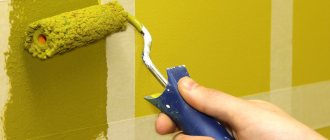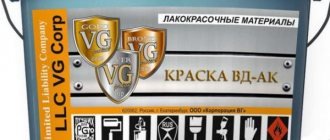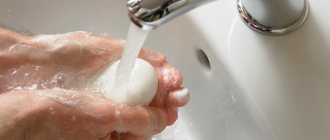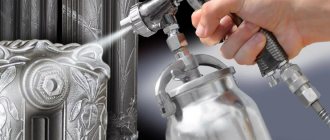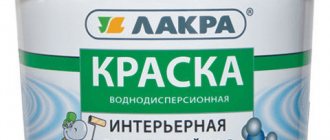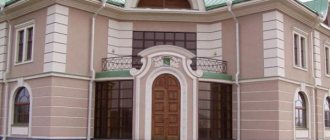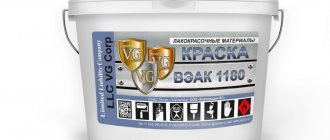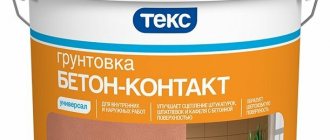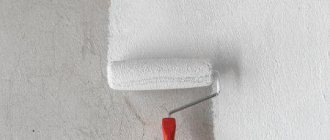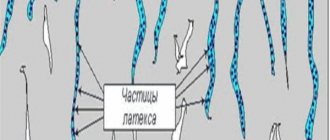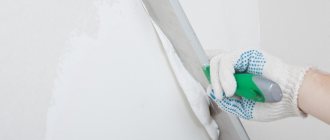PF-115 paint has high adhesion to various surfaces, therefore it is used when carrying out finishing work, for painting metal structures and mechanisms. It has decorative properties and is resistant to ultraviolet radiation and moisture. After hardening, its layer is elastic, which reduces the likelihood of cracking and chipping while the painted objects are flexible. PF-115 enamel, the technical characteristics of which differ depending on the color, according to GOST, may have a different ratio of components. As a result, it may have a different operational life.
Color depth
How to decipher the name
PF-115 enamel was developed and launched on the market more than 60 years ago. Despite the fact that there are more modern compositions, it is still considered one of the most popular for various types of finishing work. Its popularity is justified by its affordability and breadth of application. The paint is manufactured in accordance with GOST 6465-76.
Attention! To reduce the cost of the composition, some manufacturers change the chemical composition of the enamel, which often negatively affects its performance properties. You can determine such a product based on the information on the jar about compliance with the specifications. Almost always paint according to GOST is the best.
What does paint made according to GOST look like?
The name PF-115 is a marking. The letter designation consisting of the symbols “PF” indicates that pentaphthalic varnish is used as a binder base in the enamel . This substance belongs to alkyd resins. It is thanks to this that pentaphthalic enamel can be used for external and internal work. The numerical part of the name also carries information. The number “1” indicates the possibility of using paint in different temperature conditions, and the inscription “15” is a serial number, which is determined in GOST.
About some shades
Artistic oil paints are available in a wide range of shades, but when choosing them you should consider some points. By what characteristics can you choose quality products? Below is useful information for artists.
| Name of shades | Briefly about production | Binder or base for oil paints | Hue |
| Zinc white | For preparation, an electrolytic method is used, which produces zinc dioxide. | Flaxseed or nut oil | Cream |
| White lead | Lead carbonate is used as the basis for preparation. | Walnut or flaxseed oil | They differ from zinc in that they leave warm streaks on the canvas. |
| Titanium white | Titanium dioxide is used as a base. | Vegetable or artificial oil | Rich white color |
| Yellow Neapolitan | Nitric oxide combines with antimony acid. The composition uses zinc white, ocher and cadmium yellow. | Oil is produced on the basis of natural or inorganic binders | Light yellow with golden |
| Cadmium yellow | Made from magnesium and zinc sulfates | Natural or artificial oils are used as a binder | Colors from light yellow to dark yellow |
| Cadmium red tones | Made from cadmium selenide and sulfite | The binder can be based on natural or artificial oils | Orange to purple |
About some features of zinc white we can say that:
- they dry relatively slowly;
- their cover rate is average;
- if you make a palette based on them, the strength of the mixture during coloring will increase;
- the properties of not losing whiteness are inherent in them;
- in a dark room they turn yellow, but under direct exposure to sunlight their saturation is restored;
- under the influence of external negative factors, whiteness is not lost;
- Whitewash is used to work as a base for other paints.
About lead white:
- if you draw on paper, then the types of these paints are more viscous;
- dry quickly and at the same time give faster drying to other paints;
- fit perfectly on the surface and adhere to it;
- These oil paints can cover the surface the first time, their hiding power is high;
- despite the advantages, such paints emit harmful substances;
- under the influence of external negative factors they quickly darken, but at the same time under the influence of sunlight they retain their whiteness.
About Yellow Neapolitan:
- if you draw with oil on paper, you can note that this product has a fairly high viscosity;
- quick-drying oil base;
- this color quickly darkens, although it is sufficiently resistant to sunlight.
About some features of cadmium yellow paints:
- if mixed with zinc-based paint, the color will darken;
- color changes when adding paints with iron oxides;
- do not change color even after complete drying on the surface;
- It is best to dilute with nut oil;
- Coverability is high.
Advice! If mixed with blue flowers, you can get a lot of amazing green tones.
About some features of cadmium paints:
- the name suggests that it is based on a cadmium-tone pigment;
- high ability to cover the surface;
- when using solvent No. 2 it darkens.
Important! Ladoga is a good artistic paint and is in demand among art masters.
Physical state and composition
As for the physical state, alkyd paint is a viscous mixture of liquid with a suspension of solid particles. It contains:
- color;
- pigments;
- White Spirit;
- desiccant;
- pentaphthalic varnish;
- titanium dioxide.
Depending on the shade, the chemical composition of the enamel may differ. This is partly expressed by the different percentages of components. Colors that are excellent in color have their own richness. For the nominal volume of one paint, you literally need a couple of drops of color additive, and for others, tens of times more.
Color palette
Video - Enamels PF-115. Which is better?
The difference in chemical composition directly affects the performance properties of the dry coating obtained as a result of drying the paint layer. The most stable is white enamel, since 28% pentaphthalic varnish is added to it. In blue paint it is 26%, and in gray paint only 20%. Many components for providing and fixing color can make the composition more wear-resistant, so it cannot be said that white enamel will be the best in terms of operation.
Types of primers for metal against rust
Primer enamels differ in color. The palette of decorative anti-rust is not inferior to the artistic range of colors. Classic colors are:
- white,
- black,
- grey,
- brown.
If desired, you can find original colors for painting enamel:
- golden,
- green,
- wine red,
- red-brown
- rapeseed yellow
- blue and others.
The classification, based on the composition of anti-corrosion additives, distinguishes several functional varieties:
- Insulating. Excellent protection from atmospheric factors (moisture, temperature changes).
- Passivating. Effectively reduces corrosion in high humidity conditions.
- Transformative. Capable of qualitatively dissolving rust and restoring metal.
- Phosphating. They protect galvanized surfaces well in wet conditions.
- Protective. They contain metal particles, therefore they form a durable metallized layer.
- Inhibitory. They have high adhesion and excellent priming properties.
Technical characteristics of PF-115
This material has a number of properties that make it the optimal choice for achieving decorative, stable color and long-term protection of the painted surface. The components used for its manufacture are relatively inexpensive, which makes this product affordable.
Table 1. Properties of PF-115 enamel.
| Characteristic | Meaning |
| Mass fraction of substances remaining after drying | 48-71% |
| Gloss level | from 50.5% |
| Viscosity at 20°C | 60-123 |
| Cure time at 20°C | up to 24 hours |
| Hardness | 0,20-0,25 |
| Impact resistance | up to 40 |
| Covering power | 60-115 g/m2 |
| Consumption | 100-200 g/m2 |
| Substrate temperature during application | from +5 to +35°C |
| Operating conditions | -50…+60°C |
The complex chemical composition of enamel requires careful handling. You need to protect your eyes and skin from droplets. The paint contains flammable substances. This prohibits its use near fire sources. Alkyd enamel has a pronounced odor and moderate toxic properties. When used indoors, constant ventilation is required until evaporation is complete.
Wood staining
Advantages and disadvantages of enamel
This paint coating is sold at very affordable prices, which makes it possible to use it even for large-scale exterior painting work. Due to its composition, this paint is extremely resistant to moisture, precipitation, solar radiation, detergents and industrial oils. The temperature at which this material retains its properties varies from +60 to -50 degrees Celsius. In temperate climates, properly applied paintwork lasts up to 4 years. The tropical climate reduces this period to 1 year. In addition, the enamel adheres well to primer, metal and wooden surfaces.
The disadvantages include the relatively long drying time, the smell, which not everyone likes, and the difficulty of washing off painting tools. Many people, having never washed their paint brushes after it, prefer to throw them away. In this case, the paint belongs to the category of toxic and fire hazardous substances.
Purpose and use
PF-115 is a universal paint, thanks to which the composition can be used for painting:
- wood;
- concrete structures;
- cement plasters;
- bricks;
- stone;
- metal
Attention! Although the paint adheres well to various materials, it cannot be used on surfaces subject to strong heating. First of all, this concerns the roof. created with its help on slate or sheets of tin can crack and fade. It is destroyed by a combination of ultraviolet radiation and heat.
Enamel should be applied only when the temperature range is from +5 to +35°C. Its use for painting hot heating radiators and other warm communications is unacceptable. In this case, an unnaturally rapid evaporation of volatile substances occurs, and as a result, accelerated drying is observed. Such a layer does not gain sufficient binding properties. Surfaces painted under such conditions are prone to cracking, loss of color and flakes.
An example of proper painting of a cold heating radiator with PF-115 enamel
Enamel is ideal for interior work, as well as for painting outdoor surfaces that are in the shade or not heated. Paint can be used as the only means of protection and decoration, and such paint is applied to a special primer, antiseptic impregnation and rust converters. When using PF-115 on hygroscopic surfaces that will be in an important environment, the use of antibacterial and antiseptic additives is required. The paint itself does not have such properties.
Dried enamel-painted surfaces can be used in various thermal conditions from -50 to +60°C. To ensure such stability, the paint must be applied in several layers. Single-layer application is allowed only if old coatings are renewed without cracks or blisters. Even with multi-layer application, the composition retains its elasticity.
Example of painting street structures
Prices for Enamel PF-115
Enamel PF-115
How long does acrylic paint take to dry?
Acrylic paint is popular in various fields due to its exceptional properties.
The resins included in the paint coating give the painted surface a decorative appearance that is resistant to fading in the sun and aggressive environmental influences. Acrylic paints dry quickly, and therefore are widely used in external and internal works, for hobbies and painting.
How long does acrylic paint take to dry?
Drying of acrylic directly depends on the surface being painted. Thus, smooth materials (metal, glass, plastic) take longer to dry than porous materials (cardboard, concrete, wood, paper, fabric, etc.). The initial hardening of the layer takes on average 0.5-2 hours, depending on the thickness. For example, acrylic paint VD AK 111, intended for painting buildings and premises of any type, dries within an hour. Full strength gain occurs in approximately 30 days. The drying process is accelerated if favorable conditions are created:
If you plan to apply several layers, then each subsequent one increases the “setting” period.
Acrylic paints have dried out - what to do?
Knowing how long acrylic paint takes to dry, it’s easy to guess that a poorly closed container will cause damage to the paint product.
In some cases, the dried composition can be diluted with water and returned to its original state, with the exception of situations where the paint was previously frozen. True, you can no longer expect a perfect result and the original brightness - acrylic that has dried in a jar is difficult to restore. At a temperature of 20-25 degrees, a thin layer of paint stops sticking to your hands after 30 minutes. More intensive application requires 2 hours to dry. At the same time, it is not recommended to test the “strength” of a painted surface for at least a day. When the air temperature is below 10 degrees Celsius, working with acrylic paints is not recommended - the drying period will take a long time.
How to dilute dried acrylic paint?
If the paintwork has dried to a rubbery state, you can try diluting it slightly with water directly in the jar. There are several more ways to “bring back to life” the composition, but the result of coloring is difficult to predict. So:
- You can purchase a special acrylic paint thinner,
- Solvent and white spirit are effective,
- A labor-intensive method: crush the paint into powder and heat it in a water bath (or dilute it with boiling water). You can use alcohol instead of hot water.
These manipulations will help you obtain the desired consistency, but most likely the shade will fade and the coating will no longer be as even. Experts recommend not wasting time on “reanimating” dried acrylic, because... It is virtually impossible to achieve good adhesion to the surface and its former strength after drying.
What tools are needed for painting?
Alkyd enamel PF-115 is compatible with any painting tools:
- brush;
- roller;
- spray.
The fastest application is achieved with a pneumatic or electric sprayer. The slowest way to work is with a brush. When spraying enamel, more solvent is added so that the nozzle of the paint gun can create a normal spray pattern. The degree of dilution with white spirit or solvent may vary between different manufacturers, as well as the shelf life of the paint. Information about this can be found on the back of the enamel jar. The use of a roller provides high speed work, but is accompanied by increased material consumption.
Spray painting
Prices for paint sprayers
Spray gun
Features of application on different bases
Like most other decorative coatings, alkyd enamel can be applied with any hand tool or sprayer. PF 115 has technical characteristics regarding viscosity and fluidity that allow this to be done. The choice in favor of a roller, brush or spray gun is made based on the type of surface, the desired speed of application and the need to save money: the least amount of composition is consumed when using a brush, the most when using a roller. The spraying method is also quite consumable, but to use it, the paint is diluted with a solvent according to the manufacturer’s instructions.
What is the paint consumption depending on the color?
The light transmittance of different colors is different, so in some cases 2 layers of enamel are enough, and in others 3 or more. For this reason, the actual consumption of PF-115 in different shades may differ by 4 times. This largely depends on the color of the base itself, which is painted. If you have a suitable primer, paint consumption is reduced.
Table 2. Technical data on the consumption of PF-115 per 1 m2 (depending on its color, for single-layer application).
| Color | Consumption in kg per 1 m2 |
| White | 0,1-0,14 |
| Black | 0,05- 0,06 |
| Gray | 0,07-0,11 |
| Blue | 0,07 -0,1 |
| Brown | 0,07-0,8 |
| Red | 0,1-0,2 |
As you can see, the most economical in terms of application is black paint. If you choose red color, you will need 200 g/m2. The calculation proposed in the table shows the consumption when applying one layer. The actual cost of the enamel will depend on how many times it is coated. A more accurate calculation can be made using the formula by multiplying the consumption indicated in the table by the number of layers and a coefficient of 0.9.
Painting fences with enamel
The presence of the coefficient in the formula is due to the fact that each new layer is less consumable than the previous one. When planning to use PF-115 enamel, you need to take into account that painting work will require considerable time. The fact is that the break between layers should be 24 hours at room temperature. That is, re-painting occurs after the previous cover has completely dried.
Paint consumption depending on color
How to choose the right enamel
Paint can be applied in a variety of ways, depending on the surface it is applied to. Among the most popular tools, it is worth noting such as a brush, roller or spray bottle, which will evenly distribute the substance.
Enamels have their own classification, which reflects the aesthetic and practical aspects of the use of such substances. Therefore, it will be quite difficult for a person who has recently encountered the need to use such paint to determine which enamel is better.
The first question that arises in such a situation is how to choose the right enamel? What exactly should you be guided by so as not to make mistakes? To get started, consider the following factors:
What is the surface on which you will apply paint? Some types of enamels are universal, that is, they can be used both outside and indoors, and are also not picky about the structure of the surface itself. However, if you choose a substance for any specific type of work, then it is better to turn to specialized models, since different types of enamels have different resistance to temperature changes, concentration of sunlight, etc. For which surface is this or that type of enamel recommended? Concrete, brick, wood, metal or plastic have different abilities to absorb and retain paint. If you make the wrong choice, the enamel can not only be unevenly distributed on the outside of the material, but also fade quite quickly
Therefore, it is important to study the characteristics of the behavior of a particular paint model on the surface you need. How long does it take for enamel to dry? As a rule, this parameter can vary from 1 hour to two days
This factor is also important for those rooms that need to be used as soon as possible (for residential premises this is the kitchen, bedroom, bathroom). It should be borne in mind that at different temperatures the paint can dry for different times, so it is very important to choose the right time of year for the work. In addition, the smell of enamel is often very pungent, so it is worth taking into account that additional time will be required to dry it. to ventilate the room. The structure of the selected enamel. The color range of paint in modern production is so wide that the user can choose the one suitable for implementing the most daring decisions. But you should pay attention to how different shades can be combined in external texture. Currently, glossy, semi-glossy, as well as matte and rich-matte structures of the outer layer of enamel are distinguished. Therefore, it is worth determining in advance exactly what effect you want to achieve with the final result. How many layers of paint does it require to accurately achieve your idea? In fact, this is how many times it will be necessary to pass the enamel over the surface to obtain the desired saturation and uniformity. As a rule, depending on the characteristics of the chemical composition, no more than three layers are required.
But the given factors are indicative, that is, you should rely on them in order to understand what kind of paint you need to carry out the intended work. In the modern world, chemical production produces a huge number of different models of enamel paint.
Many users who want to improve their home or apartment as much as possible are wondering what is better: film or enamel. In such a dilemma, experts advise choosing the latter, since this coating will not only provide external effectiveness to the decor of a room or any specific part of the room, but will also make the enamel last much longer. If the film tends to detach from the surface, which is facilitated by its reduced adhesiveness, then the paint covers it more densely, so it is more stable. In addition, if you have pets in the house, for example, a cat, this risks causing scratches or even partial peeling on the film. For this reason, enamel is a more reliable substance when decorating certain surfaces.
Painting schemes
It is quite natural that different materials require different amounts of paint applied. In this regard, it is necessary to consider the most popular painting schemes, the observance of which allows one to achieve maximum performance and protective properties of the decorative surface.
General step-by-step instructions for using PF-115 paints
To achieve maximum performance properties of the coating, all painting conditions must be met. The sequence of actions is as follows:
Step 1. Clean the surface from dirt, grease, dust and other deposits.
We clean the surface from excess deposits
Step 2. Dry the surface if necessary.
If necessary, we can use a heat gun
Prices for popular models of heat guns
Heat guns
Step 3. Treat with antiseptics (if it is wood or a mineral base) or primer, in the case of metal.
We carry out surface treatment
Step 4. Mix the paint, adding a solvent if necessary.
Stir the paint to the required consistency
Step 5. Paint in 2-3 layers with an interval of 24 hours.
Painting the surface
How to paint metal
All types of metal, be it steel, cast iron, aluminum or copper, are painted only over a previously applied primer. GF O119, VL O5, GF O21 and similar compositions can be used as it Primers compatible with enamel have an “O” in their name. It is allowed to use PF-115 without primer on non-critical surfaces operated in dry conditions at normal temperatures. With this solution, the first layer of enamel is diluted with white spirit in a ratio of 50%. The liquid composition penetrates into the recesses on the metal surface, and after hardening it creates a good basis for the normal adhesion of subsequent layers.
Painting of metal structures
Application of PF-115 to rusty surfaces is not allowed. The corrosion layer must be treated with special rust converters. Such chemicals are applied only after cleaning from scale and dirt. This is done using a metal brush or angle grinder. After chemical interaction, the corrosion products are converted into a solid base, which can become a basis for painting. Enamel can be applied to metal using any technical means. 2 layers excluding primer are considered optimal
How to paint wood
The surface of the wood is painted with enamel without using a primer. 2-3 layers are considered optimal . This amount is due to the property of wood to absorb moisture. Ideally, pre-treat with antiseptic and fungicidal agents. You need to make sure they are compatible. Most of these compositions are designed specifically for acrylic paints. When combined with alkyd enamels, the latter swell. The use of preliminary impregnations reduces the moisture absorption of wood. This reduces actual paint consumption.
Wood painting
Note! If it is necessary to achieve high smoothness of wood without protruding pile, after applying and hardening the first layer, light sanding of the surface is allowed. Subsequently, the treated area is dusted and painted 2 more times. In this case, it is necessary to observe a technological pause between them for drying.
Painting mineral surfaces
The enamel is suitable for coating masonry, aerated concrete, concrete and plasters. In this case, it is used without priming. Apply 2-3 layers. Just as with wood, it is advisable to use preparations to prevent mold. The resulting decorative surface has low vapor permeability, so residual moisture in the mineral material itself can cause mold. As a result of damage to the base, the paint will begin to crumble. Preliminary use of impregnations is especially important for old surfaces that contain pest spores.
Using PF-115 for painting a concrete floor
When applying PF-115 to a mineral surface, it is necessary that its residual moisture be at a level of up to 15%. Fresh concrete, plasters and brickwork must be painted no earlier than 6 months from the date of completion of construction. The interval between layers is also 24 hours. To ensure high enamel adhesion, the surface to be treated must be dust-free.
Properties of enamels
Viscosity of base enamels
The viscosity of base enamels can vary significantly. Even enamels made on the same base, but in different colors, can differ significantly in viscosity.
Control of the viscosity of enamels is necessary to ensure sufficient coverage. For working mixtures of enamels applied by spraying, a viscosity of 15 ... 18 sec is recommended. DIN4.
Ensure color repeatability
To ensure color repeatability, the enamel in the container must be thoroughly mixed for several minutes before use, preferably in a gyroscopic mixer, or if it is not available, with a special stirrer. Over time, pigments in enamels gather into large conglomerates, and if they are not broken up, the color will differ from the desired one.
Polishability of enamels
Glossy enamels are well polished. However, some technologists prefer to use matte enamel with a finishing coat of glossy varnish for polishing, since at the stage of grinding the enamel for polishing there is a risk of a significant reduction in the thickness of the film (grinding) and the soil underneath it being visible.
Spreadability and drying of enamels
Enamels must have good spreadability and a fairly high dry residue, since inhomogeneities are especially noticeable on an opaque coating.
Enamels usually take longer to dry than clear varnishes, especially glossy enamels.
Primers for enamel
Enamels are usually applied to pigment primers that have a particularly high solids content. There are soils of different colors, mainly three colors: white, brown and black.
In what cases are primers of other colors used?Most often, a white primer is used, but when painting with enamels of some rich shades of yellow and red (on a transparent base), the pigments in which have a fundamentally lower hiding power, there is a risk of the primer showing through (for example, at the corners of a part). |
In this case, to reduce the visibility of local imperfections, it makes sense to use a primer of a less bright color (brown, black) or tint the primer with pigments. The same recommendation also applies to polished enamels if there is a risk of reduced hiding power.
| It should be borne in mind, however, that high accuracy of color setting is only possible with enamels that have a strictly controlled composition and a controlled amount of white. The color of the soil cannot be reproduced with such accuracy. |
| From what was mentioned in the article, we encountered the following problems when working with enamels. When trying to paint with paint from another manufacturer, but with the same number in the color catalog, we received different shades of paint and had to introduce a rule that the order must be painted with paint from one manufacturer. If the paint supplier has low technological equipment, then when re-ordering paint of a certain color, the supplier did not always match the color and sometimes it was necessary to repaint the order completely. The color of the soil is important. If, for example, red paint is applied to white or black primer, then we will get different shades of painted facades. Therefore, it was necessary to clearly specify which colors of paint to apply on black and which on white primer. In some cases, when paints were made on a transparent base, they had poor hiding power, so it was necessary to tint the white primer with paint that matched the paint with which we would paint. |
How to prepare paint
PF-115 enamel supplied in a factory can is ready for use. It does not need to be dissolved. However, during long-term storage, evaporation of its solvents is possible. As a result, the composition becomes thick. To restore its fluidity, white spirit or solvent is used. The use of gasoline and kerosene instead is undesirable, since this changes the shade of the enamel and the degree of gloss.
After opening the jar of enamel, its contents must be thoroughly mixed. The formation of a dried crust on the surface of the paint is allowed. If you use hand tools, you can leave it. For the sprayer, the paint mixed with the crust must then be filtered. The thick enamel pigment settles down during storage, so when mixing it is necessary to pay special attention to dissolving the thick suspension at the bottom. The solvent is added in several approaches. During the process, paint particles settle, so it must be stirred periodically.
Type of enamel with normal consistency
What paints are not recommended to be mixed?
Some colors of oil paints are not recommended to be mixed, and the reasons for this are as follows:
- When mixing lead white with ultramarine or colbate, an unattractive gray tint is obtained in painting. This color palette is unfortunate.
- Excessive lightening causes mixing of lead white with violet specks. Artistic paints obtained by mixing will not give the desired result.
- Natural drying oil paints cannot be mixed with paints based on artificial ingredients.
- If you use lead white to dilute dark purple ocher or rich brown color, the colors will be brightened.
- When mixing Neapolitan yellow with other tones using a palette, all the imperfections will be the same.
The choice of oil paints for painting should be made based on simple recommendations, and then we can paint with pleasure. Paints for artistic work today are available in a wide range.
Tips for beginning artists (2 videos)
Popular products (22 photos)
Popular posts
- Chair for dressing table Chairs for dressing tables in Moscow - 189 Products Company from Moscow, delivery 29643 a In…
- Silicone sanitary sealant Silicone sanitary sealant white in Moscow - 1491 products Company from Moscow, delivery (tomorrow) 140...
- Shelf in the hallway Currently, there are a huge number of different options for shelves in the hallway, and this is directly ...
- Insulation of the floor in a wooden Insulation of the floor in a wooden house from below: materials and installation technology SHARE ON SOCIAL NETWORKS One of the common…
Popular brands of enamel PF-115
Many manufacturers are involved in the production of PF-115. Some of them are guided by GOST requirements, while others make paint according to specifications. Popular brands include:
- Lakra;
- Optimum;
- Hacienda.
Lakra
The technical characteristics of this brand provide increased decorative properties. It has good adhesion. As a result of its use, a glossy surface is formed. The shelf life of Lakra paint is up to 5 years. The brand's range of matte surfaces includes only white.
Bank PF-115 Lakra
Optimum
Optimum differs from other paints in its accelerated drying about 5-7 hours. Despite this, the next layer is still applied after 24 hours. The service life of painted surfaces is 18 months. Most often used for interior decoration.
Bank PF-115 Optimum
Hacienda
Gives a semi-matte shine. The treated surface can be repeatedly cleaned from dirt using water and detergents. After hardening, the composition is highly resistant to removal even with solvents.
Bank PF-115 Hacienda
Video - Comparative test on enamel PF-115 "DEKOR"
Advantages and disadvantages
There are many arguments for the use of PF-115.
- Moisture-resistant and weather-resistant. Although some experts are skeptical about the protective properties of pentaphthalic enamel, nevertheless, it can take care of your structures, reliably limiting access to precipitation and UV rays.
- Lightfast and durable. The viability of the protective coating directly depends on the originality of the recipe and compliance with the dyeing technology. On average, the shelf life of the coating is 4-5 years.
- It has a low price - this is one of the main advantages of enamel, which often becomes a decisive factor in favor of its purchase, especially when the budget is limited.
- Provides excellent adhesion even when applied to smooth metal surfaces.
- Eliminates significant costs for preparing surfaces for painting - another opportunity to save on expensive and time-consuming technological procedures.
- Highly elastic and crack resistant.
- Highly durable and wear-resistant, therefore suitable for painting floors.
- Universal in use for external/internal types of work, for painting metal, concrete, wood. Since PF-115 can be combined well with the listed materials, it will be possible to protect various products with one product, saving on the purchase of specialized compounds for treating surfaces made of a specific material.
- It has good decorative properties and allows you to obtain a glossy, matte, semi-matte surface.
- Easy to use, can be applied using conventional painting tools or special equipment, and produces minimal shrinkage. Low-skilled personnel can work with PF-115.
- It is characterized by good fluidity, hiding power, thixotropy - the ability to reduce viscosity due to mechanical influences and to increase viscosity in a calm state.
- Easy to clean with ordinary detergents.
- A wide selection of colors, among which there are both classic, strict shades and bright, saturated ones, which makes it easier to select the right color scheme for your own needs. In addition to the standard colors of enamels produced in accordance with GOST, you can order a paint shade according to RAL.
Weaknesses are also present.
- Contains components harmful to health. The evaporation of these substances during the drying process is accompanied by a pungent odor.
- It has low vapor permeability, which must be taken into account when painting facades.
- Low levels of chemical resistance to various aggressive environments. Therefore, in some areas of the industrial sector with increased requirements for the quality of protective coatings, the use of pentaphthalic enamel is limited.
- Fire hazardous.
- Extended drying period.
To completely dry, PF-115 requires about a day, which is not always justified in terms of time and, as a result, finances.
When it comes to painting high-rise objects - water towers, chimneys, or simply the walls of multi-story buildings, industrial climbers are usually hired for the job. The services of such teams cost accordingly.
In this case, it is most profitable to paint objects “in one go” , this saves time and money. It is impossible to do this with pentaphthalic enamel, since 24 hours must pass before applying each subsequent layer. Whereas there are quick-drying enamels, the interlayer drying of which takes only half an hour, for example, the Anticorrosive Sprint coating.
In addition, PF-115 is not recommended for painting metal structures operated in aggressive industrial atmospheres, that is, those located directly in metalworking plants, thermal power plants or near them, and objects that are constantly in contact with the aquatic environment - piers, piles. Here we need more advanced materials than pentaphthalic paint, capable of providing a high degree of protection against corrosion.
PF-115 with antiseptic additives
Several brands produce enamel marked BIO. It contains biological additives that prevent the development of bacteria, viruses and fungi. This enamel belongs to the class of new paint and varnish coatings. It is used to paint walls, ceilings, windows and doors. It is recommended for interior renovations in medical institutions, kindergartens, schools, etc. The guaranteed shelf life of enamel due to the presence of bioadditives is 12 months.
PF-115 Bio
How long does acrylic paint dry on wood?
All about construction paints
How long does acrylic paint take to dry?
. is a question that is not entirely correct. To answer it, you need to understand, first of all, how the process of hardening of the binder takes place in this type of paint coating. Only after this will it become clear how to find out the more or less exact time it takes for acrylic paint to dry.
How does acrylic paint dry?
Firstly, to answer the question, how long does acrylic paint take to dry?
. First, you need to understand that acrylic paint does not dry on its own. Its binder contains a special hardener. Its task is to start a chemical reaction, due to which polymerization of the applied paint layer occurs.
It is also worth considering that the rate of polymerization is affected by the temperature at which this process takes place. Thus, it was experimentally found that the optimal temperature regime is in the range from +10 degrees Celsius to +100 degrees Celsius.
It is precisely because of such a wide range of optimal temperatures that it is impossible to accurately answer the question of how long acrylic paint takes to dry, but it is worth noting that the higher the temperature, the faster the paint coating dries.
Unfortunately, it is almost impossible to achieve sufficiently high temperatures, above +25 degrees Celsius, in domestic conditions. They can only be achieved in special painting booths. Inside such chambers, the initial drying of the paint occurs within just 30 minutes. But the complete process of hardening the paint coating does not end there. The entire polymerization process, even under ideal conditions, takes about a day.
Compatibility with other paints
Mixing PF-115 enamel with other coloring substances is not allowed. If necessary, you can mix pentaphthalic paints of different colors to achieve the desired shade. When choosing this composition for updating previously painted products, it is necessary to take into account what kind of enamel they were coated with. If the new layer of paint is incompatible with the old one, cracking, swelling and peeling of the fresh coating will occur.
Pay attention to the amazing reflective paint with its unique properties!
Compatibility of PF-115 with other coloring compounds
As you can see, PF-115 is unsuitable for coating surfaces with previously applied alkyd-acrylic, alkyd-urethane, melamine, urea, polyurethane and perchlorovinyl paint. PF-115 is a universal composition, but it cannot be called the best in all respects. Enamel creates good adhesion and color depth only if the application technology is followed with pauses between layers and preliminary surface preparation.
Recommendations for use
Surface preparation
Wooden bases must first be sanded, dust free, and dirt removed . The metal must be cleaned of rust, dirt, and remnants of old coatings. The surface is degreased. The degree of purity of the material before painting is not lower than 2 according to GOS 9.402.
Mechanical cleaning is carried out to a degree of St 3, abrasive blasting - to Sa 2 ½. It is recommended to apply PF-115 enamel over a previously primed surface. The soils FL-03k, EF-065, GF-0119, GF-021 and others are suitable for use.
Preparation of material
The enamel for painting should have a temperature of 15-25 ° C. The composition is thoroughly mixed and, if necessary, adjusted to working viscosity using white spirit, solvent, turpentine or xylene. For use in an electric field, the paint is diluted with RE-3V or RE-4V.
Application conditions
External work is carried out in dry, windless weather at an ambient temperature of +5...+30 °C and a relative humidity not higher than 85%. The base temperature must be at least 3 °C above the dew point.
Application methods
PF-115 enamel can be applied in several ways: manually with a roller or brush, by pneumatic spraying or airless spraying, by pouring, by dipping.
For manual painting, the viscosity of the composition should be in the range of 55-70 s, for pneumatic spraying - 28-30 s.
Airless spray parameters:
- paint pressure – 13 MPa;
- working viscosity – 50-80 s;
- pressure increase ratio – 1:25-1:45;
- nozzle diameter 0.28-0.48 mm;
- the torch angle is 20-60 degrees.
How to dry a painted product
There are two schemes for drying products depending on the temperature of exposure to the surface. At a temperature of 20-22 degrees - 16 hours and at 100-110 degrees - 3 hours. If in the first case the varnish BT 177 dries in natural, domestic conditions, then when exposed to artificial heat, certain requirements must be observed. Before using hot drying, keep for half an hour at 22 degrees. Before use, the product must also be exposed to 18-22 degrees for 3 hours.
There are two schemes for drying products depending on the temperature of exposure to the surface.
How long does oil paint take to dry?
- How long does oil paint take to dry?
- Solvents for removing old paint
- Floor paint for wood floors
How long does it take for painted surfaces to dry?
Oil paints are mixtures of drying oils made from natural oil or an artificial substitute, filler and coloring pigments (there are hundreds of shades of paints). They are used for painting wooden or metal surfaces (floors, walls, roofs, doors). Oil paint protects the surface from the penetration of steam or moisture. That is why this paint is often used to treat metal pipes and important structural elements of buildings.
How quickly the oil paint you choose dries depends on its formulation, humidity and ambient temperature, lighting and other external factors. Oil paint, unlike water-based paint, when drying, does not lose moisture, which is simply not present in the composition. An oil film appears on its surface due to oxidation processes. In order for these processes to occur faster, it is necessary to accelerate the interaction between the oxygen contained in the air and the paint surface.
How to paint
Experts advise carefully studying the composition of the paint indicated on the packaging. It is believed that a really good oil paint contains at least ten to twelve components. To ensure the formation of a stable oil film occurs faster, apply the paint with a brush or roller to a carefully prepared surface. On average, paint applied in a thin layer takes about a day to dry. If you do not like the unevenness of the coating or the presence of unpainted fragments, after the first layer has dried, apply another one; it will take a little longer to dry.
To speed up the oxidation process and the formation of a permanent film, you can heat the painted surface. For example, some artists, after completing their paintings, dry them using regular batteries. A heater or heater will speed up the drying of paint indoors. Heating makes the film stronger. Do not leave the heater unattended to avoid the risk of fire. If you are going to paint walls, floors or ceilings yourself, be sure to open the windows in the room, since oil paints are quite toxic and their fumes can seriously harm your health.
There are chemical accelerators for the drying process of oil paint. For example, you can add driers (or drying accelerators) to it. A small amount of them is required; you need to add driers to a can of paint, following the instructions on the package. After this, the resulting mixture must be mixed very thoroughly. Dryers significantly speed up the drying of painted surfaces, but do not affect the quality or density of oil paint.
Manufacturers
Today there are a lot of manufacturers offering a wide selection of paints and varnishes. Some of them have a long history of successful development, others offer products that are in demand not only in the domestic market, but also abroad.
In order not to get confused and purchase truly high-quality products, we will focus on the most famous and time-tested brands.
- The rating opens with one of the most popular brands today. The company offers a wide range of finishing materials used for both interior and exterior work. The PF-115 series of coloring compositions includes several types.
- "Universal". The paint is available in a wide range of colors: white, black, beige, cherry, emerald, bright green, caramel, cornflower blue, etc. The paint is suitable for painting structures and surfaces made of wood, metal, concrete, as well as chipboard and fiberboard. 1 kg of enamel allows you to cover an area of 7–13 square meters. m (1 layer). Shelf life – 2 years. The paint is available in containers of different packaging: from 0.5 to 60 kg. Level of gloss – gloss.
- "Optimum". The material is presented in 20 shades of varying degrees of saturation. Suitable for covering most types of surfaces. Not used for flooring. Consumption – 1 kg per 7–11 m Shelf life – 1.5 years. Level of gloss – gloss and matte (only for white enamels).
- "Hacienda". An ideal option for economical repairs. Consumption – 1 kg per 6–16 m2. Used for coloring wood and metal. Not suitable for floor coverings.
- "Economy". This type is most often used in mass construction. Gloss level – semi-gloss. Used for most types of surfaces. Consumption – 1 kg per 6–10 m2.
- "Empils". Under this brand, several series of paint and varnish products are produced annually, intended for both industrial and private use. PF-115 enamel is presented in several collections.
- "Dachnaya". Suitable for decorative finishing of surfaces made of most materials. Used to decorate window frames, doors, etc.
- "Simply painted." For decorating structures made of wood and metal that are exposed to weather conditions, as well as those used indoors.
- "Flourishing" Matte paint for indoor and outdoor use.
- "Empils". Glossy and matte variety for interior and exterior work.
The cost of products from different manufacturers may vary significantly. This depends on the use of coloring pigments and fillers of different quality, the popularity and “promotion” of the brand, the technical characteristics of the product, etc. And the quality of the pigment has a direct impact on such technical characteristics of the enamel as hiding power and its resistance to solar radiation. One of the most “non-fading” compositions are dyes from the Empils brand.
In the next video you will find a comparative review of PF-115 enamels.
